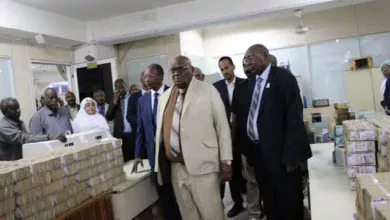Industrial Development in River Nile State – 🖋️ Prepared and interviewed by: Raja Mustafa Al-Kamel

*Nile State has become the center of attention of investors due to its natural resources and wealth. In the post-war period, the state witnessed a major economic and industrial movement that led to the establishment of a number of industrial facilities and. the entry of factories into the state… Certainly, the industrial sector needs administrative and technical efforts to continue the development and improvement of work, and when it is in charge It is a special type of woman… who excels in her knowledge and work… and works in silence and calm, away from lights and noise… and as everyone testifies, she is sincere and dedicated to serving everyone who knocks on her door, and people are equal… Dr. Nada Al -Rih, Director of the General Administration of Industry and Environment of the Ministry of Investment, in an interview on the administration's efforts to address the challenges and obstacles of the industrial renaissance of the state:*
*Q1/ Tell us about the elements of industry in River Nile State?*
The Nile State has natural agricultural and animal resources, water sources and various mineral resources that enable the state to achieve a major industrial renaissance, in addition to human resources that represent the need of citizens for basic goods and their increase in conditions of development. war, in addition to attracting investors through the availability of agricultural land and investment in the state.
*Q2/ What services does the Department of Industry and Environment provide to the investor?*.
The Department of Environment and Industry extracts all documents that guarantee the investor's rights in accordance with the procedures approved by the state government, such as the industrial registry certificate, which includes all data on the industrial facility, as well as quality and environmental control and other supervision services, providing production inputs, control and advice on problems encountered in the working environment, technical consultations and advice in addition to the planning service for primary industries.
*Q3/ What are the most important industrial areas and cities in the state*?
All localities in the state have industrial zones that include small cottage industries, and there are plans to create three industrial cities in the state. In addition, a large number of lands are currently being distributed through investments to develop the industrial sector, and we have a tendency to form small industrial complexes for a number of localities.
*Q4/ What are the challenges and obstacles facing the industrial development of the state?* The most important challenges are infrastructure preparation, electricity supply, coordination, work hubs, supervision, foreign exchange, crude transportation and high prices of energy sources and production inputs.
*Q5/ Why are there no factories serving the manufacturing industry in the state*?
Certainly, manufacturing industry has a major role in industrial renaissance, and most of the factories in the state are working in the field of manufacturing industry, and the plan we are currently working on is that manufacturing industries complement each other through upstream and downstream relationships to reduce production costs and support the local product.
*Q6/What are the problems the investor faces and what are the administration's efforts to reduce them*?
The relocation of a large number of factories to Nile State due to war conditions and the lack of ready-to-operate and fully serviced sites poses a major dilemma for investors. Some resort to leasing or purchasing, which increases production costs. Administration is simplified and free of complexity. Field visits are conducted by the administration to factories to further improve and monitor the industrial sector in the state.
*Q7/Does the administration tend to appropriate the industrial projects of interested persons?
The administration is a government agency and has no property power, but we have policies that encourage investors through the administration's vision of creating industrial complexes, providing training and technical services, and overcoming obstacles faced by investors.
*Q8/How did the war negatively and positively affect industrial activity in the state*?
One of the most positive things that happened during the war period was the significant expansion of the industrial sector, the diversification of industrial activities and the entry of new activities into the state, which created economic activity in terms of employment of workers and the provision of services. goods and basic needs. The negative impact was manifested in the irregularity of some factories and their compliance with legal procedures.
*Q9/What is the role of management in promoting local manufacturing culture*?
The Department carries out many activities and participations to raise awareness about promotion methods and provide support, technical advice and assistance in the form of solutions to all the obstacles faced by the industrial sector. There are a number of cooperating banks that provide production inputs and investors are linked to them, as well as coordination with a number of relevant ministries and institutions.
*Q10/What treatments did the administration take in the absence of the local product?*
Certainly, the high cost is one of the most important reasons for the weakness of local production, and we connect investors with entities that overcome the obstacles facing production, such as banks that finance the industry and entities that provide production inputs, as well as entities that provide technical support, training and coordination with entities concerned with the development of the industrial sector.
*Q12/What is the state's need for industrialization*?
There are many wasted resources that could be put to better use, the most important of which are high quality hides, as well as slaughter waste from which an industrial product can be extracted, and crops that have come into production in the state, such as cotton, sesame, agricultural waste and many types of minerals that the state possesses, such as manganese, mica and iron.
*Q13/How to benefit from non-independent resources and develop the state's industrial sector*?
It is necessary to provide practical research, research and planning centers according to the statistics of available quantities of all resources in the state, prepare preliminary studies on priority and missing industries and encourage investors to develop local products.
*Q14/ Tell us about the administration's partnerships with organizations and entities concerned with the development of the industrial sector*?
We have important partnerships with a number of institutions, the most important of which are banks specializing in financing industrial facilities and some technical institutions such as the Standards and Metrology Authority, the departments of investment and agriculture, and intersections with the ministries of youth, sports, and social affairs, the Ministry of Health, the Zakat office and certainly the Ministry of Finance constitutes the most important intersection.
*Q15/Training is the basis of industrial renaissance. What is the activity and orientation of management in this regard*?
The administration has organized numerous training courses in cooperation with the Federal Ministry of Industry through specialized centers in technical training and safety and environmental aspects. The administration has also taken care to train its executives in industrial inspection and control, and the training is monitored and continues. process targeting executives related to work and the private sector.
*Q16/ What is the administration's plan to develop industry in the state*?
The plan we are currently working on is to develop industrial zones and create complexes for small industries that elevate the local product to the export level.
*Q17/ What do you think is the future of industry in the State*?
Looking at the current reality, it is possible to predict a promising future and a major industrial renaissance through the great change and acceleration of production and activity that has occurred in the state, including the expansion and diversification of industrial activities and the entry of a number of enterprises. factories into the production circle. The state is witnessing a demand from investors, and all these are indicators of the development of the future of industry in the state.





